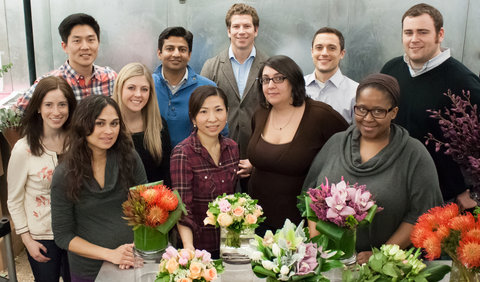 Vanessa K. Rees Hoi-Sun Tong (left) and Franya Barnett (right) are “process rhinos.” Sonu Panda is co-founder and chief operating officer.
Vanessa K. Rees Hoi-Sun Tong (left) and Franya Barnett (right) are “process rhinos.” Sonu Panda is co-founder and chief operating officer.
Building the Team
Hiring, firing, and training in a new era.
Sonu Panda is an animal.
As co-founder and chief operations officer of H.Bloom, Mr. Panda is maniacally focused on the minute details of our business. His mission is clear: to make sure that each delivery that we make is a luxurious experience for our customers. To aid him in his quest, he is building an internal consulting group made up of folks who carry an unusual title: process rhino.
In a column for Forbes called The Rhino Principle, Paul Johnson described the rhinoceros as single-minded: “When it perceives an object, it makes a decision – to charge. And it puts everything it’s got into that charge.” Our process rhinos are putting everything they’ve got into analyzing the daily processes that enable H.Bloom employees to buy the best flowers, design exquisite living art, produce remarkable arrangements and deliver those arrangements to our corporate and consumer customers.
If you are wondering why I’m writing about Mr. Panda and rhinos, it’s about training. In my last three posts, I’ve written about our fundamental belief in gaining a competitive advantage through practice, how we facilitate management classes, and how we emphasize the lessons learned in those sessions. Today, I want to describe the dedicated team that we are building to identify and document the best way to do things at H.Bloom. The playbook that they create will enable us to provide better training to our team. And, it is with better training that we will ensure we deliver the best products and services to all of our customers.
In the first of the these posts, I referred to our SEED Program, where we train aspiring business leaders to run the operations of future H.Bloom markets. Today, graduates of the program manage four of our five markets, and we have another four folks in the program currently. Until now, though, the training has focused almost exclusively on the job, rotating trainees through all aspects of a market’s operations and shadowing the existing market manager. It has been learning by doing.
The ideal training program would provide SEED participants with a playbook, enumerating every process that happens within an H.Bloom market and identifying the right way to do things. Practice makes perfect only if you are practicing how to do things perfectly. We needed to take the time to analyze our operations, but everyone involved in our operation was already working at full capacity. In order to analyze the processes and build our playbook in a meaningful time frame, we needed a dedicated team to do it. So, we are creating a team of internal consultants — our team of process rhinos.
We are hiring these folks from outside of the company, so that they bring an unbiased perspective when determining whether processes are optimal. Instead of coming from a background of deep experience at H.Bloom, these new full-time employees will apply the Socratic method of asking question after question until they identify our best practices. We rationalized the additional expense of this team in a very straightforward way. First, if we build a team of process rhinos, and they help us expand rapidly to cities around the world, their amortized cost will be negligible. Second, if their work to build the playbook has a positive impact on the rate at which we expand to new regions – directly affecting the slope of our revenue growth – the investment will be well worth it.
Here’s the plan that Mr. Panda has laid out: Examine existing operational processes. Document those processes with great detail. Seek feedback from all stakeholders to determine the best ways to do things. Roll out the new procedures to all markets. Track what happens. Build a new training curriculum for SEED participants.
With a playbook, all employees in an operational role will train faster, retain more, and have fewer on-the-job questions. Moreover, our SEED participants will now have a formal curriculum to augment the on-the-job training. This is particularly important as we begin to accelerate our expansion in the coming months.
Mr. Panda has already hired two of the rhinos, and he is actively looking for a third. The profile of the ideal candidate is simple – someone who is smart and has the ability to synthesize a lot of information and then can disseminate new standards across the company. The person will also have to be ready and willing to work hard.
If all of this works, we will deliver a better product and better service to our customers. We are making a big bet on training, and with this internal consulting group, we are investing in the people and playbook to ensure that we train well. Now that Mr. Panda has hired a team to develop our playbook, he meets with them weekly for status updates, but otherwise, he gets back to his role as C.O.O. and gets out of their way.
Once you find a team of rhinos to analyze and optimize your processes, it’s best not to get in the way of their charge.
Bryan Burkhart is a founder of H.Bloom. You can follow him on Twitter.
Article source: http://boss.blogs.nytimes.com/2013/05/30/why-we-are-hiring-outsiders-to-critique-our-performance/?partner=rss&emc=rss
